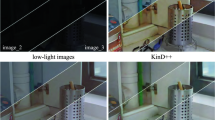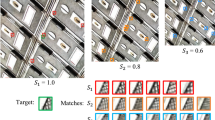Abstract
It has become very popular to take photographs in everyone’s daily life. However, the visual quality of a photograph is not always guaranteed due to various factors. One common factor is the low-light imaging condition, which conceals visual information and degenerates the quality of a photograph. It is preferable for a low-light image enhancement model to complete the following tasks: improving contrast, preserving details, and keeping robust to noise. To this end, we propose a simple but effective enhancing model based on the simplified Retinex theory, of which the key is to estimate a good illumination map. In our model, we apply an iterative self-guided filter to refine the initial estimation of an illumination map, making it aware of local structure of image contents. In experiments, we validate the effectiveness of our method in various aspects, and compare our model with several state-of-the-art ones. The results show that our method effectively adjusts the global image contrast, recovers the concealed details and keeps the robustness against noise.








Similar content being viewed by others
References
Arici T, Dikbas S, Altunbasak Y (2009) A histogram modification framework and its application for image contrast enhancement. IEEE Trans Image Process 18(9):1921–1935
Chen J, Paris S, Durand F (2007) Real-time edge-aware image processing with the bilateral grid. ACM Trans Graph 26(3):article 103
Dong X, Wang G, Pang Y (2011) Fast efficient algorithm for enhancement of low lighting video. In: proceedings of Internation conference on Multimedia & Expo (ICME)
Feng Z, Hao S (2017) Low-light image enhancement by refining illumination map with self-guided filtering. In Proceedings of International Conference on Big Knowledge Workshop
Fu X, Zeng D, Huang Y, Liao Y, Ding X, Paisley J (2016) A fusion-based enhancing method for weakly illuminated images. Signal Process 129:82–96
Fu X, Zeng D, Huang Y, Zhang X, Ding X (2016) A Weighted Variational Model for Simultaneous Reflectance and Illumination Estimation. In: Proceedings of Computer Vision and Pattern Recognition (CVPR)
Guo X, Li Y, Ling H (2017) LIME: low-light image enhancement via illumination map estimation. IEEE Trans Image Process 26(2):982–993
Hao S, Li G, Wang L, Meng Y, Shen D (2016) Learning based Topological Correction for Infant Cortical Surfaces. In: Proceedings of Medical Image Computing and Computer Assisted Intervention (MICCAI)
Hao S, Pan D, Guo Y, Hong R, Wang M (2016) Image detail enhancement with spatially guided filters. Signal Process 120:789–796
Hao S, Guo Y, Hong R, Wang M (2016) Scale-aware spatially guided mapping. IEEE Multimedia 23(3):34–42
He K, Sun J (2015) Fast guided filter. ArXiv, abs/1505.00996
He K, Sun J, Tang X (2013) Guided image filtering. IEEE Trans Pattern Anal Mach Intell 35(6):1397–1409
Hong R, Zhang L, Tao D (2016) Unified photo enhancement by discovering aesthetic communities from Flickr. IEEE Trans Image Process 25(3):1124–1135
Hong R, Zhang L, Zhang C, Zimmermann R (2016) Flickr circles: aesthetic tendency discovery by multi-view regularized topic modeling. IEEE Trans Multimedia 18(8):1555–1567
Jobson J, Rahman U, Woodell A (1996) Properties and performance of a center/surround Retinex. IEEE Trans Image Process 6(3):451–462
Jobson J, Rahman U, Woodell A (1997) A multi-scale Retinex for bridging the gap between color images and the human observation of scenes. IEEE Trans Image Process 6(7):965–976
Kim Y (1997) Contrast enhancement using brightness preserving bi-histogram equalization. IEEE Trans Consum Electron 43(1):1–8
Lee C, Lee C, Kim C (2013) Contrast enhancement based on layered difference representation of 2D histograms. IEEE Trans Image Process 22(12):5372–5384
Lee J Y, Sunkavalli K, Lin Z, Shen X, Kweon I S. (2016) Automatic Content-Aware Color and Tone Stylization. In: Proceedings of Computer Vision and Pattern Recognition (CVPR)
Lim J, Heo M, Lee C, Kim C (2017) Contrast enhancement of noisy low-light images based on structure-texture-noise decomposition. J Vis Commun Image Represent 45:107–121
Liu C, Gong S, Loy C (2014) On-the-fly feature importance Mining for Person re-Identification. Pattern Recogn 47(4):1602–1615
Lore K, Akintayo A, Sarkar S (2017) LLNet: a deep autoencoder approach to natural low-light image enhancement. Pattern Recogn 61:650–662
Ni B, Xu M, Wang M, Yan S, Tian Q (2013) Learning to photograph: a compositional perspective. IEEE Trans Multimedia 15(5):1138–1151
Reza AM (2004) Realization of the contrast limited adaptive histogram equalization (CLAHE) for real-time image enhancement. J VLSI Signal Process Syst 38(1):35–44
Song J, Zhang L, Shen P, Peng X, Zhu G (2016) Single Low-light Image Enhancement Using Luminance Map. In: Proceedings of Chinese Conference of Pattern Recognition (CCPR)
Wang S, Gu K, Ma S, Lin W, Liu X, Gao W (2016) Guided image contrast enhancement based on retrieved images in cloud. IEEE Trans Multimedia 18(2):219–232
Xu L, Yan Q, Xia Y, Jia J (2013) Structure extraction from texture via relative Total variation. ACM Trans Graph 31(6):article 139
Yin W, Mei T, Chen C, Li S (2014) Socialized mobile photography: learning to photograph with social context via mobile devices. IEEE Trans Multimedia 16(1):184–200
Yue H, Yang J, Sun X, Wu F, Hou C (2017) Contrast enhancement based on intrinsic image decomposition. IEEE Trans Image Process 26(8):3981–3994
Zhang Q, Shen X, Xu L, Jia J (2014) Rolling guidance filter. In: Proceedings of European Conference Computer Vision
Zhang L, Li X, Nie F, Yang Y, Xia Y (2016) Weakly supervised human fixations prediction. IEEE Trans Cybernetics 46(1):258–269
Zhang H, Shang X, Luan HB, Wang M, Chua TS (2016) Learning from collective intelligence: feature learning using social images and tags. ACM Trans Multimed Comput Commun Appl 13(1):Article 1
Zhang H, Kyaw Z, Yu J, Chang S F (2017) PPR-FCN: weakly supervised visual relation detection via parallel pairwise R-FCN, in: proceedings of international conference on computer vision (ICCV)
Zhu Y, Lucey S (2015) Convolutional sparse coding for Rrajectory reconstruction, IEEE transactions on. IEEE Trans Pattern Anal Mach Intell 37(3):529–540
Zhu X, Zhang L, Huang Z (2014) A sparse embedding and least variance encoding approach to hashing. IEEE Trans Image Process 23(9):3737–3750
Zhu W, Cui P, Wang Z, Hua G (2015) Multimedia Big Data Computing. IEEE Multimedia 22(3):96–100
Zhu X, Li X, Zhang S (2016) Block-row sparse Multiview multilabel learning for image Cassification. IEEE Trans Cybernetics 46(2):450–461
Zhu X, Li X, Zhang S (2017) Robust joint graph sparse coding for unsupervised spectral feature selection. IEEE Trans Neural Netw Learn Syst 28(6):1263–1275
Zhu Y, Zhu X, Kim M, Yan J, Wu G (2017) A Tensor Statistical Model for Quantifying Dynamic Functional Connectivity. In: Proceedings of Information Processing of Medical Image (IPMI)
Acknowledgements
The authors sincerely appreciate the useful comments and suggestions from the anonymous reviewers. This work was supported by the National Nature Science Foundation of China under grant number 61772171, and grant number 61702156.
Author information
Authors and Affiliations
Corresponding author
Rights and permissions
About this article
Cite this article
Hao, S., Feng, Z. & Guo, Y. Low-light image enhancement with a refined illumination map. Multimed Tools Appl 77, 29639–29650 (2018). https://doi.org/10.1007/s11042-017-5448-5
Received:
Revised:
Accepted:
Published:
Issue Date:
DOI: https://doi.org/10.1007/s11042-017-5448-5




